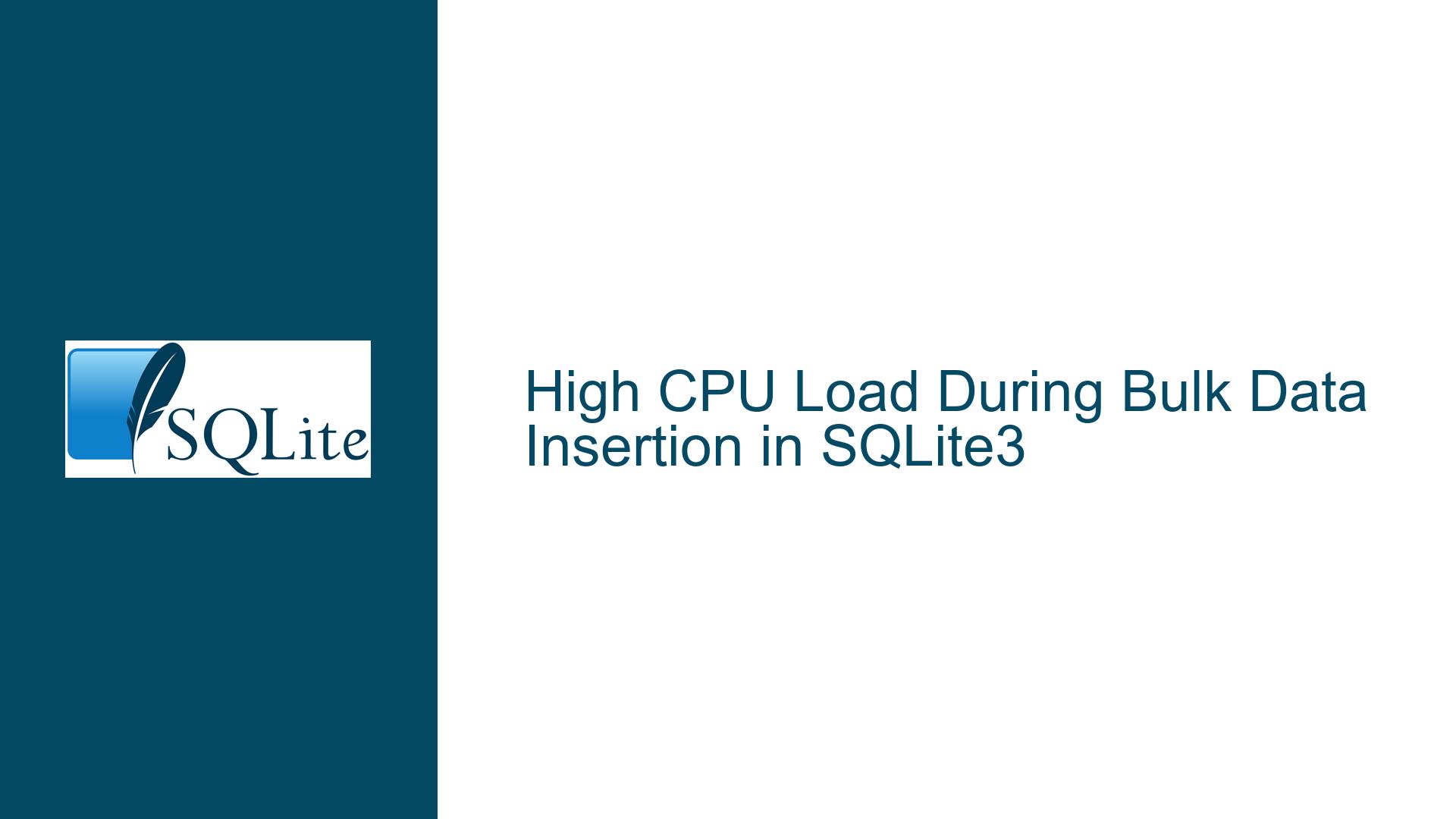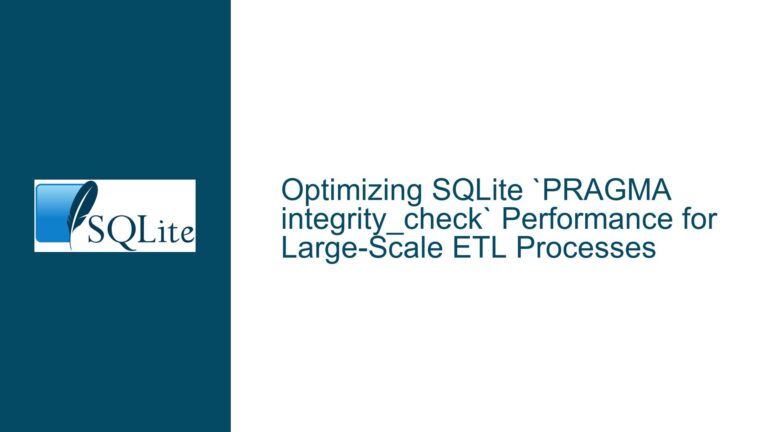High CPU Load During Bulk Data Insertion in SQLite3
Understanding High CPU Load During Bulk Data Insertion in SQLite3
When dealing with bulk data insertion in SQLite3, it is not uncommon to encounter high CPU utilization, especially when the database is under heavy write operations. The provided code snippet demonstrates a scenario where a large number of records are being inserted into an SQLite3 database, resulting in CPU load spikes of up to 90%. This issue is further exacerbated when the database is stored on faster storage media, such as SSDs, where the CPU becomes the bottleneck due to the rapid data processing capabilities of the storage device.
The core of the problem lies in the interaction between the SQLite3 library, the underlying storage medium, and the way the data insertion is being handled in the code. SQLite3, being a lightweight database, is designed to handle small to medium-sized datasets efficiently. However, when dealing with large-scale data insertion, certain optimizations and best practices need to be employed to mitigate the CPU load.
The code provided initiates a transaction, inserts a large number of records, and then commits the transaction. This process is repeated indefinitely, leading to continuous high CPU usage. The use of WAL (Write-Ahead Logging) mode does reduce the CPU load to some extent, but it does not completely alleviate the issue. This suggests that while WAL mode can help in reducing contention and improving write performance, it is not a silver bullet for high CPU load during bulk data insertion.
Potential Causes of High CPU Load in SQLite3 Bulk Insertions
The high CPU load observed during bulk data insertion in SQLite3 can be attributed to several factors. Understanding these factors is crucial for identifying the root cause and implementing effective solutions.
1. Transaction Management Overhead: The code initiates a new transaction for every batch of 100,000 records. While transactions are essential for ensuring data integrity and atomicity, they also introduce overhead. Each transaction involves acquiring locks, writing to the journal (in rollback journal mode), or managing the WAL (in WAL mode), and committing the changes. This overhead can contribute significantly to the CPU load, especially when the transaction size is large or the frequency of transactions is high.
2. String Manipulation in the Loop: The code constructs a new std::string object for each record insertion within the loop. This involves dynamic memory allocation, string concatenation, and deallocation, which can be CPU-intensive, especially when performed repeatedly in a tight loop. The repeated creation and destruction of std::string objects can lead to unnecessary CPU cycles being spent on memory management rather than on the actual data insertion.
3. SQLite3 Prepared Statement Usage: The code uses a prepared statement for inserting records, which is generally a good practice as it reduces the overhead of parsing and compiling the SQL statement for each insertion. However, the way the prepared statement is being used—resetting and clearing bindings after each insertion—can still introduce some overhead. While this overhead is relatively small compared to other factors, it can still contribute to the overall CPU load, especially when dealing with a large number of insertions.
4. Storage Medium Performance: The performance of the underlying storage medium plays a significant role in determining the CPU load during bulk data insertion. Faster storage media, such as SSDs, can process data more quickly, leading to higher CPU utilization as the CPU struggles to keep up with the rapid data transfer rates. On the other hand, slower storage media, such as HDDs, may result in lower CPU utilization as the CPU waits for the storage device to complete its operations.
5. SQLite3 Configuration and Mode: The configuration and mode in which SQLite3 operates can also impact CPU load. For example, enabling WAL mode can reduce contention and improve write performance, but it may not always result in a proportional reduction in CPU load. Other configuration options, such as synchronous settings, cache size, and journal mode, can also influence CPU utilization during bulk data insertion.
Strategies to Reduce CPU Load During Bulk Data Insertion in SQLite3
To address the high CPU load during bulk data insertion in SQLite3, several strategies can be employed. These strategies aim to optimize the code, reduce unnecessary overhead, and leverage SQLite3’s features more effectively.
1. Optimize Transaction Management: One of the most effective ways to reduce CPU load is to optimize transaction management. Instead of initiating a new transaction for every batch of 100,000 records, consider increasing the batch size or reducing the frequency of transactions. This will reduce the overhead associated with acquiring locks, managing the journal or WAL, and committing changes. However, it is important to strike a balance between transaction size and memory usage, as larger transactions may require more memory to hold the changes before they are committed.
2. Minimize String Manipulation in the Loop: To reduce the CPU load caused by string manipulation, consider pre-allocating a single std::string object outside the loop and reusing it for each record insertion. This can be achieved by reserving enough space in the string to accommodate the largest possible value and then modifying the string in place within the loop. This approach eliminates the need for repeated memory allocation and deallocation, thereby reducing CPU cycles spent on memory management.
3. Optimize Prepared Statement Usage: While using prepared statements is generally a good practice, there are still opportunities for optimization. For example, instead of resetting and clearing bindings after each insertion, consider reusing the prepared statement without resetting it for multiple insertions. This can reduce the overhead associated with resetting and clearing bindings, especially when dealing with a large number of insertions. Additionally, consider using bulk insertions or batch processing techniques to further reduce the overhead of prepared statement usage.
4. Leverage SQLite3 Configuration Options: SQLite3 provides several configuration options that can be tuned to optimize performance and reduce CPU load. For example, adjusting the synchronous setting can reduce the frequency of disk I/O operations, thereby reducing CPU load. Similarly, increasing the cache size can improve performance by reducing the need for frequent disk access. Additionally, consider experimenting with different journal modes, such as WAL or rollback journal, to determine which mode provides the best balance between performance and CPU load for your specific use case.
5. Profile and Analyze the Code: Profiling the code is essential for identifying the specific areas that contribute to high CPU load. Use profiling tools to measure the CPU usage of different parts of the code, such as transaction management, string manipulation, and prepared statement usage. This will help you pinpoint the bottlenecks and focus your optimization efforts on the areas that have the most significant impact on CPU load. Additionally, consider using SQLite3’s built-in profiling and tracing features to gain insights into the internal operations of the database and identify potential areas for optimization.
6. Consider Alternative Storage Solutions: If the high CPU load is primarily due to the performance of the underlying storage medium, consider using alternative storage solutions. For example, using an in-memory database can eliminate the overhead associated with disk I/O operations, resulting in lower CPU load. However, this approach may not be suitable for all use cases, as it requires sufficient memory to hold the entire dataset. Alternatively, consider using a slower storage medium, such as an HDD, if the performance requirements allow for it. This can reduce the CPU load by slowing down the data transfer rate and allowing the CPU to keep up with the storage device.
7. Implement Throttling Mechanisms: If reducing the CPU load is a priority and the performance requirements allow for it, consider implementing throttling mechanisms to limit the rate of data insertion. For example, introducing a sleep interval between batches of insertions can reduce the overall CPU load by allowing the CPU to idle between operations. However, this approach should be used with caution, as it may impact the overall performance and throughput of the data insertion process.
8. Explore Parallel Processing: In some cases, parallel processing can be used to distribute the CPU load across multiple cores or threads. For example, consider dividing the data insertion process into multiple threads, each handling a portion of the data. This can reduce the CPU load on a single core and improve overall performance. However, this approach requires careful synchronization and coordination to ensure data integrity and avoid contention issues.
9. Evaluate Database Design and Schema: The design of the database and schema can also impact CPU load during bulk data insertion. For example, using appropriate indexes, optimizing table structures, and minimizing the number of constraints can reduce the overhead associated with data insertion. Additionally, consider normalizing or denormalizing the database schema to optimize performance and reduce CPU load.
10. Monitor and Adjust Resource Allocation: Finally, monitor the resource allocation and usage of the system during bulk data insertion. Ensure that the system has sufficient CPU, memory, and disk resources to handle the workload. If necessary, adjust the resource allocation to optimize performance and reduce CPU load. For example, increasing the CPU priority of the SQLite3 process or allocating more memory to the database cache can improve performance and reduce CPU load.
In conclusion, high CPU load during bulk data insertion in SQLite3 can be caused by a combination of factors, including transaction management overhead, string manipulation, prepared statement usage, storage medium performance, and SQLite3 configuration. By optimizing transaction management, minimizing string manipulation, leveraging SQLite3 configuration options, profiling the code, and exploring alternative storage solutions, it is possible to reduce CPU load and improve the performance of bulk data insertion in SQLite3. Additionally, implementing throttling mechanisms, exploring parallel processing, evaluating database design, and monitoring resource allocation can further optimize performance and reduce CPU load.






